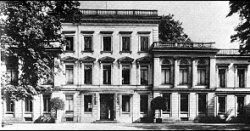Palais Rothschild-Goldschmidt, 8-10, Bockenheimerlandstraße, Frankfurt, Germany
In 1816, the banker Amschel Mayer Rothschild (1773-1855) acquired a country house (built in 1806) with a plot of land on the Bockenheimer Landstrasse, at that time called Bockenheimer Chaussee. The property was situated in a garden suburb that was newly developed at the beginning of the 19th century - the later Westend - directly in front of the former Bockenheimer Tor. Beginning in 1830, Amschel who had rarely lived there, had the existing house elaborately converted by the Frankfurt architect Friedrich Rumpf. A new storey was added, the windows given triangular gables, and the whole became an elegant palace in the style of a Roman Renaissance villa with splendid rooms for receptions and social events. Rumpf is also credited with converting the property into a park in the style of an English landscape garden from 1832, and the park was given a neo-Gothic ornamental tower that has survived to this day. In addition, a greenhouse and an orangery were also built as well as a pond in the northern part of the park, none of which have been preserved.
When Amschel died in 1855 he left the house to his nephew, Mayer Carl (1820-1886). In 1869, Mayer Carl converted the house into a good-sized mansion, for which he commissioned Richard Dielmann. In 1890, two symmetrical wings were added.
Upon Mayer Carl's death in 1886, the Palais and estate passed to his brother Wilhelm Carl (1828-1901), and then to Wilhlem Carl's widow Hannah Mathilde (1832-1924), who gave it to her daughter Minna Caroline (1857-1903) and her husband Maximilian Goldschmidt-Rothschild (1843-1940) in 1898. The Goldschmidt-Rothschilds were able to purchase neighbouring properties and replace them with parkland. By the end of the nineteenth century, in spite of the encroachment of urban Frankfurt, the Palais and its grounds had become a veritable retreat.
The Second World War
In September 1938, the National Socialist city administration forced the by now widowed and elderly Maximilian von Goldschmidt-Rothschild to sell the park grounds and Palais to the city far below their value. The park was opened to the public in 1941 and renamed Wöhlerpark in 1943. The Palais was destroyed in an air raid on Frankfurt in 1943, and the orangery burned down the following year. Since 1950 the property has belonged to the City of Frankfurt, which compensated the former owners, but in the following decade reduced the estate in size by selling off land for new building plots.
The site today
Between 2007 and 2009 the park and surrounding grounds underwent some redevelopment. The former Palais is now commemorated by a monument in the southern part of the park, which reproduces part of the original ground plan of the building and includes a sandstone stele from 1878 with the coat of arms of Amschel Mayer Rothschild.
Return to Estates listing